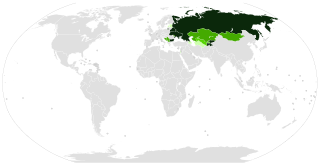
Kyrgyz is a Turkic language of the Kipchak branch spoken in Central Asia. Kyrgyz is the official language of Kyrgyzstan and a significant minority language in the Kizilsu Kyrgyz Autonomous Prefecture in Xinjiang, China and in the Gorno-Badakhshan Autonomous Region of Tajikistan. There is a very high level of mutual intelligibility between Kyrgyz, Kazakh, and Altay. A dialect of Kyrgyz known as Pamiri Kyrgyz is spoken in north-eastern Afghanistan and northern Pakistan. Kyrgyz is also spoken by many ethnic Kyrgyz through the former Soviet Union, Afghanistan, Turkey, parts of northern Pakistan, and Russia.

Bashkir or Bashkort is a Turkic language belonging to the Kipchak branch. It is co-official with Russian in Bashkortostan. It is spoken by 1.09 million native speakers in Russia, as well as in Ukraine, Belarus, Kazakhstan, Uzbekistan, Estonia and other neighboring post-Soviet states, and among the Bashkir diaspora. It has three dialect groups: Southern, Eastern and Northwestern.
Three scripts are currently used for the Tatar language: Arabic, Cyrillic and Latin.

Faux Cyrillic, pseudo-Cyrillic, pseudo-Russian or faux Russian typography is the use of Cyrillic letters in Latin text, usually to evoke the Soviet Union or Russia, though it may be used in other contexts as well. It is a common Western trope used in book covers, film titles, comic book lettering, artwork for computer games, or product packaging which are set in or wish to evoke Eastern Europe, the Soviet Union, or Russia. A typeface designed to emulate Cyrillic is classed as a mimicry typeface.

Karakalpak is a Turkic language spoken by Karakalpaks in Karakalpakstan. It is divided into two dialects, Northeastern Karakalpak and Southwestern Karakalpak. It developed alongside Nogai and neighbouring Kazakh languages, being markedly influenced by both. Typologically, Karakalpak belongs to the Kipchak branch of the Turkic languages, thus being closely related to and highly mutually intelligible with Kazakh and Nogai.

Buryat or Buriat, known in foreign sources as the Bargu-Buryat dialect of Mongolian, and in pre-1956 Soviet sources as Buryat-Mongolian, is a variety of the Mongolic languages spoken by the Buryats and Bargas that is classified either as a language or major dialect group of Mongolian.
The Common Turkic alphabet is a project of a single Latin alphabet for all Turkic languages based on a slightly modified Turkish alphabet, with 34 letters recognised by the Organization of Turkic States. Its letters are as follows:

The Kyrgyz alphabets are the alphabets used to write the Kyrgyz language. Kyrgyz uses the following alphabets:

Three alphabets are used to write Kazakh: the Cyrillic, Latin and Arabic scripts. The Cyrillic script is used in Kazakhstan, Russia, and Mongolia. An October 2017 Presidential Decree in Kazakhstan ordered that the transition from Cyrillic to a Latin script be completed by 2031. The Arabic script is used in Saudi Arabia, Iran, Afghanistan, and parts of China.

There are 4 stages in the history of Yakut writing systems:

Numerous Cyrillic alphabets are based on the Cyrillic script. The early Cyrillic alphabet was developed in the 9th century AD and replaced the earlier Glagolitic script developed by the theologians Cyril and Methodius. It is the basis of alphabets used in various languages, past and present, Slavic origin, and non-Slavic languages influenced by Russian. As of 2011, around 252 million people in Eurasia use it as the official alphabet for their national languages. About half of them are in Russia. Cyrillic is one of the most-used writing systems in the world. The creator is Saint Clement of Ohrid from the Preslav literary school in the First Bulgarian Empire.
JCUKEN is the main Cyrillic keyboard layout for the Russian language in computers and typewriters. Earlier in Russia JIUKEN (ЙІУКЕН) layout was the main layout, but it was replaced by JCUKEN when the Russian alphabet reform of 1917 removed the letters Ѣ, І, Ѵ, and Ѳ. The letter Ъ had decreased in usage significantly after the reform.

Russian Braille is the braille alphabet of the Russian language. With suitable extensions, it is used for languages of neighboring countries that are written in Cyrillic in print, such as Ukrainian and Mongolian. It is based on the Latin transliteration of Cyrillic, with additional letters assigned idiosyncratically. In Russian, it is known as the Braille Script.
Ukrainian Braille is the braille alphabet of the Ukrainian language. It is based on Russian Braille, with a few additional letters found in the print Ukrainian alphabet.
Mongolian Braille is the braille alphabet used for the Mongolian language in Mongolia. It is based on Russian Braille, with two additional letters for print letters found in the Mongolian Cyrillic alphabet.
The braille alphabet used for the Kazakh language is based on Russian Braille, with several additional letters found in the print Kazakh alphabet.
Belarusian Braille is the braille alphabet of the Belarusian language. It is based on Russian Braille, with a couple additional letters found in the print Belarusian alphabet.
The braille alphabet used for the Tatar language is based on Russian Braille, with several additional letters found in the print Tatar alphabet.
Even alphabets are the alphabets used to write the Even language. During its existence, it functioned on different graphic bases and was repeatedly reformed. At present, Even writing functions in Cyrillic. There are three stages in the history of Even writing:
The Dobrujan Tatar alphabet is the writing system of Dobrujan Tatar. Before 1956 only Perso-Arabic script was used and after 1956, Latin alphabet was adopted.









